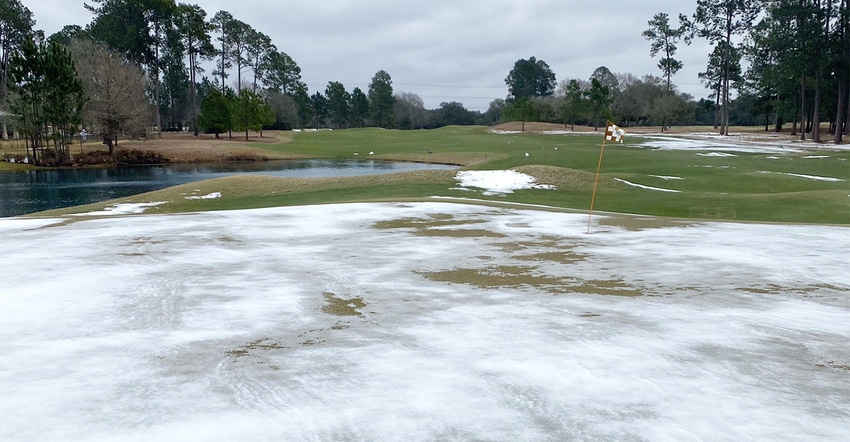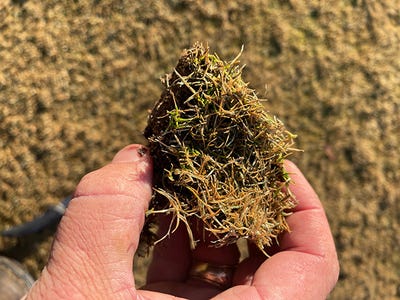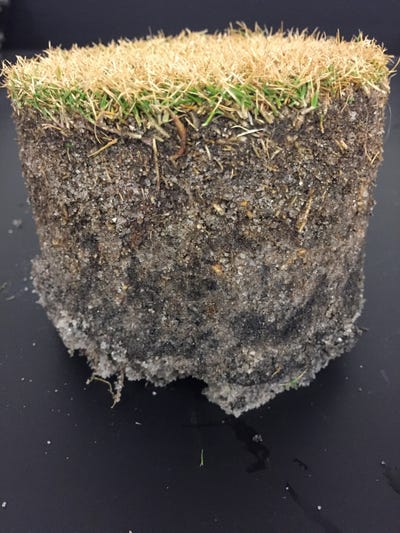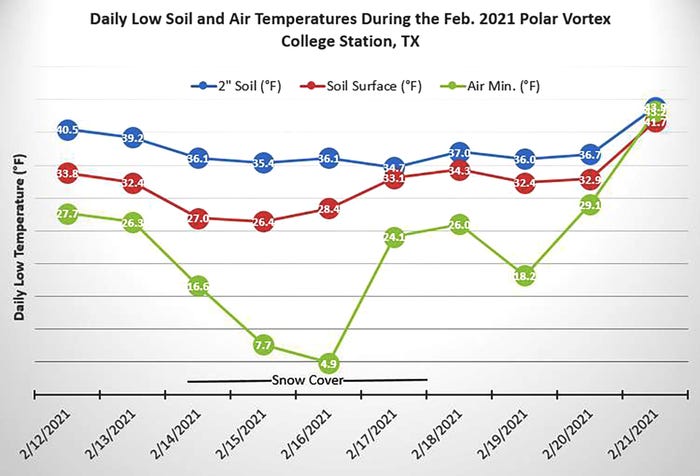
Many Texans are wondering how their turfgrass will respond come spring after Mother Nature unleashed the recent arctic snap across southern regions unaccustomed to such freezing temperatures.
The low temperatures experienced in many parts of Texas rivaled record lows not seen in over 100 years, but it was the sheer duration of sub-freezing temperatures that was more concerning, according to Texas A&M AgriLife Research and Texas A&M AgriLife Extension Service turfgrass experts.
“For example, the Dallas-Fort Worth area encountered the second-longest period of below-freezing temperatures on record,” said Chrissie Segars, AgriLife Extension turfgrass specialist, Dallas. “Ironically, although the Houston area experienced 1-degree wind chills, these frigid temperatures were only the lowest on record since 1990.
“Perhaps the one blessing in disguise for plants during this event was the snowfall that came along with it, blanketing the state as far south as Brownsville, where measurable snow had only fallen twice since record keeping began over 120 years ago,” Segars said.
See, Livestock merit second look for latent storm effects
“Patience is key this spring, as delayed recovery and green-up may be expected from rhizomatous species including Bermuda grass and zoysia grass,” she said. “This is going to be the case where low-temperature kill injured stolons/rhizomes near the surface, but regrowth may still be possible from deeper in the canopy where temperatures were stabilized near or above freezing during the multiday freeze event.”
Winter injury of warm-season turf
Winter injury of warm-season turfgrasses may arise due to numerous factors, including direct low- temperature kill or freeze injury, suffocation under prolonged ice cover, frost injury and desiccation during windy, dry conditions, said Ben Wherley, AgriLife Research turfgrass ecologist in the Texas A&M Department of Soil and Crop Sciences, College Station.
Of these, freezing injury due to exposure to prolonged low temperatures would be the greatest risk to grasses during an extended deep freeze like the one occurring recently, Wherley said. Although all warm-season grasses have some degree of built-in winter dormancy mechanisms, their relative tolerance to subfreezing temperatures goes only so far and varies depending on the species and cultivar.
 Freeze-damaged Tifway fairway turfgrass with new green tissue starting to show through. (Texas A&M AgriLife photo)
Freeze-damaged Tifway fairway turfgrass with new green tissue starting to show through. (Texas A&M AgriLife photo)
In general, he said, buffalo grasses possess superior low-temperature tolerance, which can be seen in the extent of their northern adaptation, extending all the way into Canada. Zoysia grasses possess the next best cold tolerance, with cultivars such as Meyer being grown as far north as southern Indiana and Ohio.
Although Bermuda grass cultivars with enhanced cold tolerance have been developed in recent years, such as Latitude 36 and Northbridge, they generally possess moderate cold tolerance, limiting their use to the southern transition zone and southward.
Among the warm-season grasses, centipede grass, seashore paspalum, St. Augustine grass and ultra-dwarf Bermuda grasses, typically used on putting greens, all possess the least cold tolerance and are those of most concern following cold snaps like the one experienced recently.
Freeze resistance, survivability
So, what’s the difference between species or cultivars with high and low freezing resistance? The answer lies in a grass species’ ability to “harden-off” or acclimate during the fall months, as temperatures begin to drop going into winter, Wherley said.
During the acclimation process, freeze-resistant plants begin to dehydrate their cells by accumulating solutes, including sugars and ions such as potassium within the cell, which act in a similar way to antifreeze, he explained.
“This is one of the major reasons we apply late-season applications of potassium to warm-season turf,” Wherley said.
 A plug removed from an area of freeze-damaged zoysia grass with new green tissue seen emerging from deep within the canopy. (Texas A&M AgriLife photo)
A plug removed from an area of freeze-damaged zoysia grass with new green tissue seen emerging from deep within the canopy. (Texas A&M AgriLife photo)
Freezing injury, therefore, is most common in plants that have not acclimated, or are unable to acclimate to low temperatures, leading to ice formation within the cell and subsequent rupture of cellular contents, he said.
While the risk of direct low-temperature kill varies based on turfgrass species and cultivar, numerous other stresses may also set the plant up for greater risk, including shade, traffic, drainage issues, direction of slope and soil compaction, Segars said.
When assessing the potential for low-temperature injury, focus on temperatures at or near the soil surface during the period of concern combined with the duration of the subfreezing exposure.
“In the absence of snow, ambient air temperatures may be a good means of estimating soil surface temperatures,” she said. “However, if snow is present, as was the case with the recent cold snap, it insulates the turf, creating a physical barrier to heat loss which often keeps the turf near or even above freezing. In fact, this is the same reason that golf courses cover greens with winter blankets during subfreezing conditions.”
When considering low-temperature thresholds combined with the more than three days of subfreezing temperatures, the outlook for warm-season turfgrass survival and recovery would seem very bleak were it not for the timely snowfall that occurred and insulated the ground through most of the extreme cold.
“While it’s likely that spring green-up may be delayed in many areas and stands may be thinner than usual, we are cautiously optimistic that we will see favorable spring recovery of warm-season turf stands across much of South-Central Texas,” she said.

In the Bryan-College Station area, although air temperatures dropped into the single digits over multiple nights, upper soil temperatures never fell far below freezing, which may have aided the chances for warm-season turf survival, Wherley said. Winterkill of some of the more sensitive warm-season grasses begins in the mid 20’s.
For more northerly regions of the state including the Dallas-Fort Worth region, where even lower temperatures were encountered, winterkill is likely to be more widespread, primarily for St. Augustine grass lawns and ultra-dwarf Bermuda grass greens.
Diagnosing potential winterkill: Quick methods for assessing viability of turf areas
Patience is key in assessing winter injury of turfgrass in its entirety. There are a few steps that you can take right now to assess the potential for winterkill in your turfgrass areas.
Step 1: Collect turfgrass plugs from suspected low-temperature damaged areas. This may include varying areas that receive more shade, endure higher amounts of traffic, have drainage issues, on north-facing slopes, or have greater soil compaction.
Step 2: Place the turfgrass plug in a container that contains native soil or sand similar to that used in the root zone.
Step 3: Place the container in a sunny location such as a southern-facing window indoors or greenhouse.
Step 4: Keep plugs adequately watered. Growth/greening should begin in seven to 10 days.
Step 5: Assess the crown region for signs of green leaf tissue and overall green coverage after plugs have grown for approximately two to three weeks.
Step 6: You may choose to repeat the sampling procedure on a 14-to-21-day interval throughout periods of cold weather.
Turf considerations for this spring: Fertility and herbicide strategies
When a period of potential winter stress or injury occurs, there are some further considerations for input use during the spring transition period, the two turfgrass experts said.
“Often, periods of potential winter injury occur during contemplations for spring fertilizer and herbicide use,” Segars said. “The extent of winter injury may be unknown at this time. During the period of the unknown, it is recommended not to rush applications of fertilizer or herbicides and to avoid, if able, applications of selective herbicides to areas that have potentially been weakened by winter injury.”
See photo gallery, Winter storm 2021
Wherley said this is also a great time to consider taking a soil test. This will allow preparations for the potential establishment of new grass but also to recover the areas that were not killed by the cold temperatures.
“It is our recommendation to hold off on the addition of fertilizers until potential winter damage can be assessed,” Segars said. “This will allow proper applications of nutrients that can be taken up by actively growing plants and will not be lost to the environment. Once turfgrass begins actively growing, the addition of fertilizer will aid in recovery. Once temperatures are conducive, spoon-feeding with frequent, lower rates of complete fertilizer may be needed to encourage recovery of thin or damaged areas.”
Another consideration is foregoing the application of preemergence products during the spring transition period in areas where winter injury is suspected and wait until full spring green-up has occurred.
“This will allow scouting of areas that may need to be replanted and will help avoid the slowing of recovery from the application of preemergence herbicides,” she said. “This option would rely on early scouting for troublesome weeds and the use of postemergence products for early spring weed control.
“Should you find that areas do not need to be reseeded or resodded, an option would be to tank-mix a pre- and post-emergent product for your initial application. This would allow the pre-product to stop further emergence of summer annual weeds and allow the post-product to clean up any immature summer annual weeds that may have emerged during the green-up period.”
If moderate to heavy winterkill has occurred, Wherley said, avoid applications of pre-products if reseeding or resodding will be done right away. Preemergence products have varying soil residuals, so time applications before or after seeding/sodding.
Both experts advised all to remember to always read the label for product use around newly established turfgrass.
Source: is AgriLife TODAY, which is solely responsible for the information provided and is wholly owned by the source. Informa Business Media and all its subsidiaries are not responsible for any of the content contained in this information asset.
Read more about:
TurfgrassAbout the Author(s)
You May Also Like




